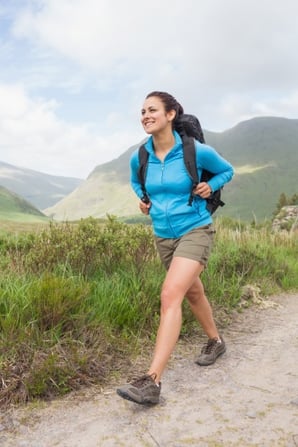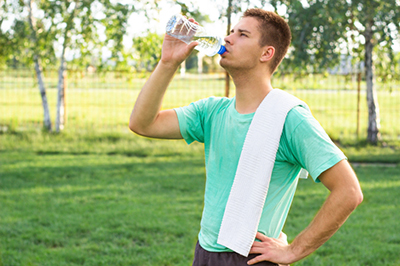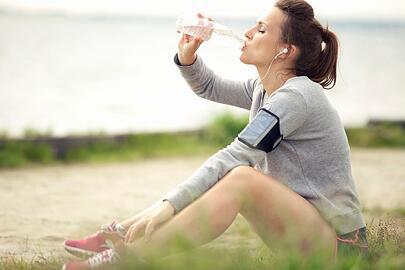 The weather is warming up, the flowers are coming out, and daylight is around much longer at night. All of these things mean one thing: time to start grilling again! Having a barbecue or cookout is a wonderful way to do a majority of your cooking because it is a healthy preparation method and leaves little to no cleanup in the kitchen!
The weather is warming up, the flowers are coming out, and daylight is around much longer at night. All of these things mean one thing: time to start grilling again! Having a barbecue or cookout is a wonderful way to do a majority of your cooking because it is a healthy preparation method and leaves little to no cleanup in the kitchen!
However, there can be some safety concerns when it comes to grilling, so read below to make sure you are informed.
Follow Proper Meat Temperatures
One of the most common reasons for food poisoning is not cooking your meat to the proper temperature. In fact, only 23% of Americans say they use a meat thermometer. This is the easiest and best way to make sure you are cooking your meat to the proper temperature. Here are the food safety temperature guidelines for different types of meat:
- Chicken: 165 degrees
- Pork: 145 degrees
- Hamburgers: 160 degrees
- Steak: 145 degrees
- Bratwurst: 160 degrees
- Fish: 145 degrees
- Leftovers: 165 degrees
Use Condiments and Marinades Safely
Another thing to be cautious about is condiment safety. Always be sure to marinate meat in the refrigerator vs. sitting out on a counter or out by the grill. If you are reusing the sauce used on raw meats, bring it to a boil before using it on cooked meats; or throw it away to prevent cross-contamination. Condiments should not be left sitting out for more than 2 hours (1 hour if the temperature is above 90 degrees).
Don’t Reuse Cutting Boards and Platters
Something that might happen if you are in a hurry (or trying to cut down on dirty dishes) is to use the same cutting board or platter that had the raw meat on it for chopping veggies, or to put the cooked meat back on it. This can definitely be a recipe for disaster, so be sure to grab a different platter or cutting board, or clean the original one thoroughly with hot soapy water before using again.
Wash Hands and Utensils
Finally, don’t forget about those tools and your hands! This is where a lot of bacteria from the raw meat can reside. Thoroughly wash your grilling utensils once they have come in contact with the raw meat instead of just hanging them up on the side of the grill. Also, be sure to wash your hands and the grill handle that you touch with your hands after handling the raw meat.
Taking these small extra steps can guarantee a spring and summer filled with delicious (and safe) foods from the grill! And here are some tips for healthy eating at your next barbecue.
This blog was written by Angie Mitchell, RD, Wellness Coordinator. To find out more about the NIFS bloggers, click here.


 Summertime is in full swing, and whether you are a competitive or recreational athlete, changes are definitely happening to your normal schedule. For high school and collegiate athletes, more time is spent at home and for general fitness enthusiasts, more options are available to you to fulfill your exercise quota (in other words,
Summertime is in full swing, and whether you are a competitive or recreational athlete, changes are definitely happening to your normal schedule. For high school and collegiate athletes, more time is spent at home and for general fitness enthusiasts, more options are available to you to fulfill your exercise quota (in other words,  For many who enjoy the summer months for different
For many who enjoy the summer months for different  During the summer, the days are stretching longer, the temperatures are rising, and the sun is shining brighter! It’s time to enjoy the outdoors. Whenever I visit bigger cities, I notice that their parks are packed with people enjoying picnics, which is one of my favorite things to do to explore and discover a new outdoor space. So let’s bring the picnic to our local parks! Surprise your significant other, take the family out for an afternoon in the park, or enjoy time with friends playing football or frisbee.
During the summer, the days are stretching longer, the temperatures are rising, and the sun is shining brighter! It’s time to enjoy the outdoors. Whenever I visit bigger cities, I notice that their parks are packed with people enjoying picnics, which is one of my favorite things to do to explore and discover a new outdoor space. So let’s bring the picnic to our local parks! Surprise your significant other, take the family out for an afternoon in the park, or enjoy time with friends playing football or frisbee. So many people have been expectantly waiting for this hot summer weather to be able to get outside for their workouts. And I can tell you that I am also one of those people; but there are some dangers behind the dog days of summer that we all need to be aware of.
So many people have been expectantly waiting for this hot summer weather to be able to get outside for their workouts. And I can tell you that I am also one of those people; but there are some dangers behind the dog days of summer that we all need to be aware of. Paddleboarding
Paddleboarding One of my favorite things to do once it is summer in Indiana is to visit the various farmers’ markets around town. As a dietitian I am a sucker for the
One of my favorite things to do once it is summer in Indiana is to visit the various farmers’ markets around town. As a dietitian I am a sucker for the 

 Dehydration can lead to heat illnesses, so it is important to stay hydrated and drink water even if you do not feel like you are thirsty. Read more about this in our
Dehydration can lead to heat illnesses, so it is important to stay hydrated and drink water even if you do not feel like you are thirsty. Read more about this in our 
 dehydrated, including feeling thirsty, tired, or dizzy; having a headache; and having dark-colored urine, to name a few. If you start to experience these side effects, you must rehydrate yourself before the situation becomes a medical emergency. Do not try to continue exercise if you feel you are becoming dehydrated!
dehydrated, including feeling thirsty, tired, or dizzy; having a headache; and having dark-colored urine, to name a few. If you start to experience these side effects, you must rehydrate yourself before the situation becomes a medical emergency. Do not try to continue exercise if you feel you are becoming dehydrated!